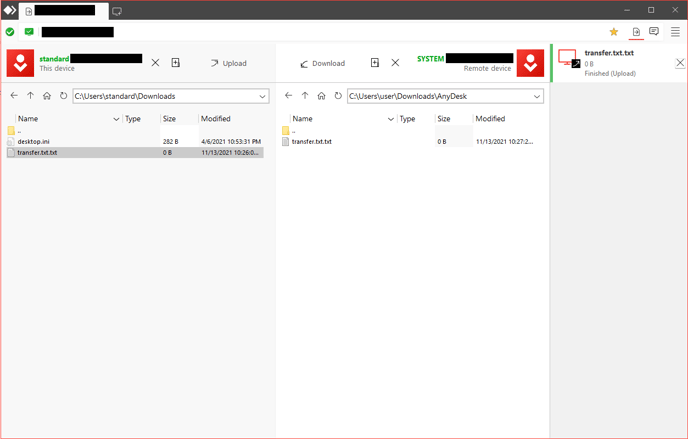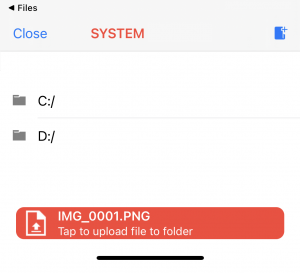Title: "Complete Guide to AnyDesk File Manager and File Transfer | How to Transfer Files with AnyDesk"
File Manager and File Transfer
Table of Contents
| File Manager | File Transfer | Disable File Transfer | File Transfer with MacOS |
|---|---|---|---|
| File Transfer with Linux | File Transfer with Android | File Transfer with iOS |
AnyDesk provides a range of options for transferring files between local and remote endpoints. This can be achieved through a “File Manager” session or via “File Transfer” during a remote control session.
File Manager
The dedicated file manager feature is currently available on Windows, macOS, and Linux.
It can operate alongside an interactive session or through a dedicated File Manager session.
Upload: Transfer selected files into the corresponding directory
Download: Retrieve selected files from the remote device
This Device: Current directory, always displayed on the left
Remote Device: Current directory of the partnering device, always displayed on the right
Directories: “Arrow up” and “Double Dot Folder” (always heading) change to the parent directory
To start a dedicated File Manager session, simply click the
Alternatively, you can right-click a tile in Favorites, Recent Sessions, Discovery, or the Address Book and select “Browse Files”.
To use the File Manager during an interactive remote control session, simply start it up from the AnyDesk Toolbar.
A history of transferred and edited files while in this view can be found in the Accept Window.
File Transfer
AnyDesk provides the ability to synchronize clipboards between local and remote endpoints, applicable to both text and files.
This feature is offered through the “copy & paste” functions available on all major platforms. Currently, there are two supported methods of doing so using AnyDesk:
- Using hotkeys - for example:
- Selecting one or more files on the remote endpoint,
- using the shortcut CTRL+C to copy the files,
- opening a folder on the local endpoint,
- using the shortcut CTRL+V to transfer the files to the local endpoint.
- Using the context menu - for example:
- Selecting one or more files on the local endpoint,
- right-clicking the selected files and selecting “Copy” to copy the files,
- opening a folder on the remote endpoint,
- right-clicking an empty area in the folder and selecting “Paste” to transfer the files to the local endpoint.
Disable File Transfer
To disable clipboard transmission, disable:
- “Access my computer’s clipboard”
- and “Access my computer’s clipboard to transfer files”
in the profile you wish to disable it for in Settings > Security > Permissions > Permission Profile.
The first option will disable clipboard sync in both directions for both text and files while the second will only disable file transfer using the clipboard.
On the remote endpoint, File Transfer can be temporarily enabled or disabled in the Accept Window.
On the local endpoint, File Transfer can be temporarily enabled or disabled in Permissions in the AnyDesk toolbar.
File Transfer with MacOS
When copying one or multiple files to a macOS endpoint, a pending file transfer request will show on the remote endpoint. To access the transferred file(s), click the red file icon in the AnyDesk toolbar or the orange File Transfer icon in the Accept Window, and a macOS Finder window will appear with the transferred file(s).
File Transfer with Linux
File Transfer to Linux devices exhibits different behaviors depending on whether the Linux device is the local or the remote endpoint.
Local Endpoint
To transfer one or more files from a remote endpoint to a local Linux-based endpoint:
- Copy the files you wish to transfer to the remote endpoint.
- The default File Explorer will appear on the local Linux endpoint with the transferred file(s).
Remote Endpoint
To transfer one or more files from a local endpoint to a remote Linux-based endpoint:
- Copy the files you wish to transfer to the local endpoint.
- Open the Accept Window in the remote Linux endpoint, go to the “File Transfer” tab, and click “Accept Files”.
- The default File Explorer window will appear on the remote Linux endpoint with the transferred file(s).
File Transfer with Android
Transfer a file from an Android device to a desktop-based platform:
- Session Menu > Actions > Transfer a file to the remote device
- Select a file to transfer
- On the remote desktop-based platform, open the File Explorer and navigate to the desired transfer location
- Right-click the transfer location area and select “Paste”
Transfer a file from a remote desktop-based platform to an Android device:
1. On the remote desktop-based platform, use the context menu or a shortcut to copy the file you wish to transfer to the Android device
2. Session Menu > Actions > Download a file from the remote device
File Transfer with iOS
For AnyDesk 5.1.0 and newer, file transfer between an iOS and non-iOS operating system is possible.
File transfer to and from tvOS devices is currently not possible.
Transfer a file from an iOS device to a non-iOS device:
- Use the “Share” action on the file you wish to transfer within the Apple File application, select “More,” then “AnyDesk.”
- As of AnyDesk 5.2.0, this Share to AnyDesk feature is also available in the Apple Photos application.
- AnyDesk will automatically open, where you can enter or select the AnyDesk-ID you wish to transfer the file to.
- After the remote computer has accepted the AnyDesk connection, you can navigate to the desired save location and tap the red bar at the bottom to transfer the file.
Retrieve a file from a non-iOS device:
- Enter the AnyDesk-ID/Alias of the device you wish to retrieve the file from on the iOS device
- Hold the “Connect” button, and a prompt will appear, asking if you want to “Connect” regularly or start a File Transfer session.
- Once the remote device has accepted the connection, the iOS device will be transferred to a File Explorer view.
- Select the file you wish to retrieve and tap the red download button at the bottom of the screen.
- Select the location where the downloaded file should be saved on the iOS device.
- Published at


